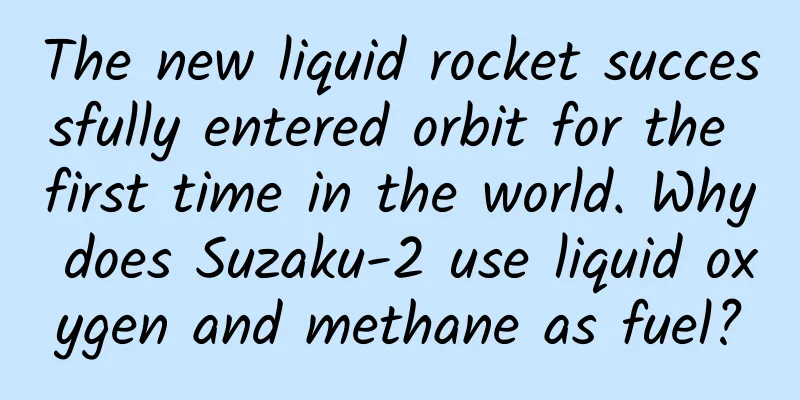The new liquid rocket successfully entered orbit for the first time in the world. Why does Suzaku-2 use liquid oxygen and methane as fuel?

|
On the morning of July 12, the Suzaku-2 Yao-2 liquid oxygen-methane carrier rocket (hereinafter referred to as Suzaku-2) independently developed by Blue Arrow Space Technology Co., Ltd. was launched from the Jiuquan Satellite Launch Center. The rocket entered the predetermined orbit and the test mission was a complete success. Zhuque-2 is the world's first liquid oxygen-methane rocket to successfully enter orbit, marking a major breakthrough in the application of new low-cost liquid propellants in my country's launch vehicles. This is also the first successful launch of a liquid oxygen-methane launch vehicle in China's private commercial aerospace sector. "The Zhuque-2 rocket carries our research and development process from '0 to 1'." Zhang Changwu, CEO of Blue Arrow Aerospace, said that in the past few years, the company has developed the Tianque series of engines, built test benches, cold test systems, etc., and completed nearly 100,000 seconds of ground tests in total. It has successfully developed the only liquid oxygen-methane rocket engine in China with mature flight technology, which supports the power system of Zhuque-2. This mission is the second flight of the Suzaku-2 launch vehicle. At the end of 2022, the Suzaku-2 Yaoyi rocket conducted its first flight test. This test failed due to a rupture in the secondary pipeline of the engine. In the first flight, the rocket power system and structural system were relatively completely verified. After the first flight, through the subsequent "zero return" verification, the management problems involving interface management and joint design were remedied. Zhuque-2 is a two-stage liquid rocket that uses liquid oxygen and methane as fuel. The rocket body diameter is 3.35 meters, the full rocket height is 49.5 meters, the takeoff weight is 219 tons, and the takeoff thrust is 268 tons. The maximum diameter of the fairing is 3.35 meters and the total length is 8.237 meters. The first stage of the rocket uses four Tianque 80-ton liquid oxygen-methane engines in parallel, and the second stage uses a combination of a Tianque 80-ton liquid oxygen-methane engine and a Tianque 10-ton floating liquid oxygen-methane engine. Compared with solid rockets, liquid rockets have the advantages of high specific impulse, adjustable thrust, and multiple starts, making them a better choice for recyclable launch vehicles. The use of liquid oxygen and methane as fuel is the biggest difference between the Suzaku-2 rocket and the Long March series rockets we usually see. According to Dai Zheng, deputy chief designer and deputy commander of the Suzaku-2, liquid oxygen and methane are a mixture of liquid oxygen and methane. The products of methane burning in oxygen are carbon dioxide and water, which is a clean combustion agent for launch vehicles. At the same time, this fuel is easy to mine and the technology is mature. Compared with rocket fuels such as liquid hydrogen and kerosene, it is relatively cheap, more environmentally friendly, low-cost, and easy to reuse. "In fact, if there is a large enough launch vehicle and a strong enough deep space delivery capability, it will not be difficult to prepare fuel on Mars. Now people are aiming to reuse rockets and use methane as fuel." Dai Zheng explained that the ambient temperature in outer space is low. The lowest temperature on the surface of Mars can reach -143°C, and the lowest temperature on the surface of the moon can reach -190°C, which is too high for liquid hydrogen and too low for kerosene. The flight test of the Suzaku-2 rocket mainly assessed the correctness and rationality of the test launch and flight process plan of this new liquid oxygen-methane rocket, as well as the compatibility of various system interfaces, laying the foundation for the subsequent formal commercial flight of the rocket. "We will continue to use the Suzaku series of launch vehicles as our core products, continuously optimize and iterate our products, further improve rocket performance, and provide the market with low-cost, high-performance, and large-capacity rocket products," said Zhang Changwu. Zhang Changwu revealed that a total of three test rockets were prepared for the Zhuque-2 rocket. Before this launch, the Yao-3 rocket had entered the final assembly stage. With the success of the Yao-2 mission, Landspace will deliver a small batch to the market in 2024, with an annual output of 3 to 4 rockets, and double it in 2025. At the same time, Landspace has launched a reusable rocket project and is expected to conduct a test flight mission in 2025. |
<<: Drone delivery drones have great uses in high-risk environments
Recommend
This rare water bird can even bring its own "spoon" to eat?
Recently, the monitoring team of Hubei Shennongji...
Ternary Variance - Universal Data Analysis Rule
Universal data analysis rules, mastering the essen...
What's worth buying product analysis report
On July 15, 2019, " What's Worth Buying ...
Behind Amazon's stock price plunge: continued loss forecasts make the market lose patience
Amazon released its third-quarter earnings report...
Technology News | Research confirms that e-cigarettes are harmful to bones
【Today’s cover】 In early winter, a group of water...
Frequent early awakening may be a disease. What time is considered "early"?
Have you ever had this experience: you woke up be...
How to operate a community from 0 to 1? Here are my 7 thoughts
Next, I will talk about building a community from...
Is the national pride behind the Chinese buyers' show coming a little too early?
Chinese people's "explosive buying"...
Screen burn-in is not a problem. Learn about the app that can save AMOLED screens.
Unconsciously, AMOLED screens have been able to c...
The chess-playing robot that reflects SenseTime’s profit dilemma is a big move aimed at investors?
The commercial profit map of AI leader SenseTime ...
Why Far Cry Primal is worth buying before The Division comes out
Nowadays, Ubisoft is criticized by many players. ...
If you haven’t seen this picture, you can’t say you understand data analysis?
When it comes to charts that are often used in da...
Brain-computer interface technology helps humans realize "mind communication", how far are we from the cyborg world?
After a stroke, brain damage leads to limb paraly...
Flying cars test the waters in the tourism industry, Geely Travel plans to expand into Hainan
On June 3, Geely Group (New Business) Co., Ltd., ...
The new version of the APP is launched. Have you done these operations?
The APP has just been launched, so naturally ther...









